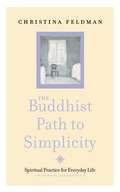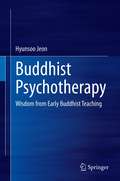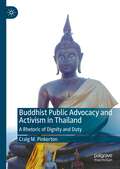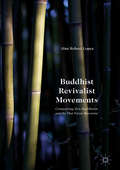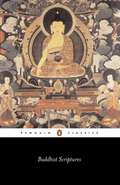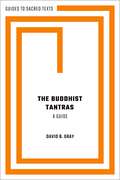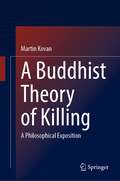- Table View
- List View
The Buddhist Path to Simplicity: Spiritual Practice In Everyday Life
by Christina FeldmanMoments of peace and stillness give us a glimpse of how extraordinary our lives can be, but it is easy to lose sight of this in the hectic pace of modern living. In this inspirational book, internationally renowned Buddhist teacher Christina Feldman shows you how to find harmony and balance by applying ancient Buddhist Wisdom to the here and now.
Buddhist Perspectives on Free Will: Agentless Agency?
by Rick RepettiThroughout the history of Buddhism, little has been said prior to the Twentieth Century that explicitly raises the question whether we have free will, though the Buddha rejected fatalism and some Buddhists have addressed whether karma is fatalistic. Recently, however, Buddhist and Western philosophers have begun to explicitly discuss Buddhism and free will. This book incorporates Buddhist philosophy more explicitly into the Western analytic philosophical discussion of free will, both in order to render more perspicuous Buddhist ideas that might shed light on the Western philosophical debate, and in order to render more perspicuous the many possible positions on the free will debate that are available to Buddhist philosophy. The book covers: Buddhist and Western perspectives on the problem of free will The puzzle of whether free will is possible if, as Buddhists believe, there is no agent/self Theravāda views Mahāyāna views Evidential considerations from science, meditation, and skepticism The first book to bring together classical and contemporary perspectives on free will in Buddhist thought, it is of interest to academics working on Buddhist and Western ethics, comparative philosophy, metaphysics, philosophy of mind, philosophy of action, agency, and personal identity.
Buddhist Perspectives on Free Will: Agentless Agency?
by Rick RepettiThroughout the history of Buddhism, little has been said prior to the Twentieth Century that explicitly raises the question whether we have free will, though the Buddha rejected fatalism and some Buddhists have addressed whether karma is fatalistic. Recently, however, Buddhist and Western philosophers have begun to explicitly discuss Buddhism and free will. This book incorporates Buddhist philosophy more explicitly into the Western analytic philosophical discussion of free will, both in order to render more perspicuous Buddhist ideas that might shed light on the Western philosophical debate, and in order to render more perspicuous the many possible positions on the free will debate that are available to Buddhist philosophy. The book covers: Buddhist and Western perspectives on the problem of free will The puzzle of whether free will is possible if, as Buddhists believe, there is no agent/self Theravāda views Mahāyāna views Evidential considerations from science, meditation, and skepticism The first book to bring together classical and contemporary perspectives on free will in Buddhist thought, it is of interest to academics working on Buddhist and Western ethics, comparative philosophy, metaphysics, philosophy of mind, philosophy of action, agency, and personal identity.
Buddhist Philosophy: Essential Readings
by William Edelglass Jay GarfieldThe Buddhist philosophical tradition is vast, internally diverse, and comprises texts written in a variety of canonical languages. It is hence often difficult for those with training in Western philosophy who wish to approach this tradition for the first time to know where to start, and difficult for those who wish to introduce and teach courses in Buddhist philosophy to find suitable textbooks that adequately represent the diversity of the tradition, expose students to important primary texts in reliable translations, that contextualize those texts, and that foreground specifically philosophical issues. Buddhist Philosophy fills that lacuna. It collects important philosophical texts from each major Buddhist tradition. Each text is translated and introduced by a recognized authority in Buddhist studies. Each introduction sets the text in context and introduces the philosophical issues it addresses and arguments it presents, providing a useful and authoritative guide to reading and to teaching the text. The volume is organized into topical sections that reflect the way that Western philosophers think about the structure of the discipline, and each section is introduced by an essay explaining Buddhist approaches to that subject matter, and the place of the texts collected in that section in the enterprise. This volume is an ideal single text for an intermediate or advanced course in Buddhist philosophy, and makes this tradition immediately accessible to the philosopher or student versed in Western philosophy coming to Buddhism for the first time. It is also ideal for the scholar or student of Buddhist studies who is interested specifically in the philosophical dimensions of the Buddhist tradition.
Buddhist Philosophy: A Comparative Approach (Blackwell Companions To Philosophy Ser. #139)
by Steven M. EmmanuelBuddhist Philosophy: A Comparative Approach presents a series of readings that examine the prominent thinkers and texts of the Buddhist tradition in the round, introducing contemporary readers to major theories and debates at the intersection of Buddhist and Western thought. Takes a comparative, rather than oppositional, approach to Buddhist philosophy, exploring key theories and debates at the intersection of Eastern and Western thought Addresses a variety of topics that represent important points of convergence between the Buddhist and Western philosophical traditions Features contributions from a wide array of acclaimed international scholars in the discipline Provides a much-needed cross-cultural treatment of Buddhist philosophy appropriate for undergraduate students and specialists alike
Buddhist Philosophy: A Comparative Approach
by Steven M. EmmanuelBuddhist Philosophy: A Comparative Approach presents a series of readings that examine the prominent thinkers and texts of the Buddhist tradition in the round, introducing contemporary readers to major theories and debates at the intersection of Buddhist and Western thought. Takes a comparative, rather than oppositional, approach to Buddhist philosophy, exploring key theories and debates at the intersection of Eastern and Western thought Addresses a variety of topics that represent important points of convergence between the Buddhist and Western philosophical traditions Features contributions from a wide array of acclaimed international scholars in the discipline Provides a much-needed cross-cultural treatment of Buddhist philosophy appropriate for undergraduate students and specialists alike
Buddhist Philosophy: Essential Readings
by William Edelglass Jay L. GarfieldThe Buddhist philosophical tradition is vast, internally diverse, and comprises texts written in a variety of canonical languages. It is hence often difficult for those with training in Western philosophy who wish to approach this tradition for the first time to know where to start, and difficult for those who wish to introduce and teach courses in Buddhist philosophy to find suitable textbooks that adequately represent the diversity of the tradition, expose students to important primary texts in reliable translations, that contextualize those texts, and that foreground specifically philosophical issues. Buddhist Philosophy fills that lacuna. It collects important philosophical texts from each major Buddhist tradition. Each text is translated and introduced by a recognized authority in Buddhist studies. Each introduction sets the text in context and introduces the philosophical issues it addresses and arguments it presents, providing a useful and authoritative guide to reading and to teaching the text. The volume is organized into topical sections that reflect the way that Western philosophers think about the structure of the discipline, and each section is introduced by an essay explaining Buddhist approaches to that subject matter, and the place of the texts collected in that section in the enterprise. This volume is an ideal single text for an intermediate or advanced course in Buddhist philosophy, and makes this tradition immediately accessible to the philosopher or student versed in Western philosophy coming to Buddhism for the first time. It is also ideal for the scholar or student of Buddhist studies who is interested specifically in the philosophical dimensions of the Buddhist tradition.
Buddhist Poetry and Colonialism: Alagiyavanna and the Portuguese in Sri Lanka
by Stephen C. BerkwitzMany researchers have explored the impact of British and French Orientalism in the reinterpretations of Buddhism in South and Southeast Asia during the nineteenth and early twentieth centuries. Less noticed, however, and infrequently discussed is the impact of Portuguese colonialists and missionaries upon Buddhist communities in the sixteenth and seventeenth centuries across Asia. Stephen C. Berkwitz addresses this theme by examining five poetic works by Alagiyavanna Mukaveti (b.1552), a renowned Sinhala poet who participated directly in the convergence of local and trans-local cultures in early modern Sri Lanka. Berkwitz follows the written works of the poet from his position in the court of a Sinhala king, through the cultural upheavals of warfare and the expansion of colonial rule, and finally to his eventual conversion to Catholicism and employment under the Portuguese Crown. In so doing, Berkwitz explores the transformations in religion and literature rendered by what was arguably the earliest sustained encounter between Asian Buddhists and European colonialists in world history. Alagiyavanna's poetic works give expression to both a discourse of nostalgia for the local religious and cultural order in the late sixteenth century, and a discourse of cultural assimilation with the new colonial order during its ascendancy in the early seventeenth century. Employing an interdisciplinary approach that combines Buddhist Studies, History, Literary Criticism, and Postcolonial Studies, this book yields important insights into how the colonial experience contributed to the transformation of Buddhist culture in early modernity.
Buddhist Psychotherapy: Wisdom from Early Buddhist Teaching
by Hyunsoo JeonThis book explores how to utilize Buddhism in psychotherapy and how Buddhism itself acts as a form of psychotherapy, using Buddhism practices as a lens for universal truth and wisdom rather than as aspects of a religion. Based on the author's over 30 years of study and practice with early Buddhism and his experiences of Buddhism with his patients, the book outlines a new form of psychotherapy incorporating three Buddhist principles: the properties of the body and mind, the principle of world’s movement, and living with wisdom. This technique provides a unique perspective on mental health and offers new approaches for clinicians and researchers to effectively addressing mental health and well-being.
Buddhist Public Advocacy and Activism in Thailand: A Rhetoric of Dignity and Duty
by Craig M. PinkertonThis book studies Buddhist public advocacy and activism in Thailand—a movement often broadly called socially engaged Buddhism—from the perspective of rhetorical studies, specifically, on humanizing and dehumanizing communication practices. In modern Thailand and historical Siam, Buddhism has been integral to the social change processes shaping civil society and an emerging democracy. This study examined two problems: How do contemporary Buddhists in Thailand use rhetorical practice to influence the way the issues they work on are understood, and how do these Buddhists justify their advocacy and activism in rhetorical practice? To the first, a rhetoric of dignity, or humanization, was the central answer. To the second, a rhetoric of duty was the central answer. For researchers in Southeast Asian Studies, Thai Studies, and Buddhist Studies, this book offers a fresh perspective on socially engaged Buddhism through the lens of the communication discipline. For researchers in Psychologyand Communication, it sheds light on the understudied practices of humanizing communication. The bulk of the current research is focused on its opposite—dehumanization—and most of this literature is in the field of psychology even though humanization and dehumanization are fundamentally and ontologically communication phenomena. For researchers within the field of Communication and Rhetorical Studies, this book advances innovations in the emerging practices of rhetorical field methods by applying rhetorical criticism to interview data in a new way and provides a non-western perspective on communication and rhetorical theory for which there has been continual calls.
Buddhist Revivalist Movements: Comparing Zen Buddhism and the Thai Forest Movement
by Alan Robert LopezThis text provides a comparative investigation of the affinities and differences of two of the most dynamic currents in World Buddhism: Zen Buddhism and the Thai Forest Movement. Defying differences in denomination, culture, and historical epochs, these schools revived an unfettered quest for enlightenment and proceeded to independently forge like practices and doctrines. The author examines the teaching gambits and tactics, the methods of practice, the place and story line of teacher biography, and the nature and role of the awakening experience, revealing similar forms deriving from an uncompromising pursuit of awaking, the insistence on self-cultivation, and the preeminent role of the charismatic master. Offering a pertinent review of their encounters with modernism, the book provides a new coherence to these seemingly disparate movements, opening up new avenues for scholars and possibilities for practitioners.
The Buddhist Roots of Zhu Xi's Philosophical Thought
by John MakehamZhu Xi (1130-1200) is the most influential Neo-Confucian philosopher and arguably the most important Chinese philosopher of the past millennium, both in terms of his legacy and for the sophistication of his systematic philosophy. The Buddhist Roots of Zhu Xi's Philosophical Thought combines in a single study two major areas of Chinese philosophy that are rarely tackled together: Chinese Buddhist philosophy and Zhu Xi's Neo-Confucian philosophy. Despite Zhu Xi's importance as a philosopher, the role of Buddhist thought and philosophy in the construction of his systematic philosophy remains poorly understood. What aspects of Buddhism did he criticize and why? Was his engagement limited to criticism (informed or otherwise) or did Zhu also appropriate and repurpose Buddhist ideas to develop his own thought? If Zhu's philosophical repertoire incorporated conceptual structures and problematics that are marked by a distinct Buddhist pedigree, what implications does this have for our understanding of his philosophical project? The five chapters that make up The Buddhist Roots of Zhu Xi's Philosophical Thought present a rich and complex portrait of the Buddhist roots of Zhu Xi's philosophical thought. The scholarship is meticulous, the analysis is rigorous, and the philosophical insights are fresh. Collectively, the chapters illuminate a greatly expanded range of the intellectual resources Zhu incorporated into his philosophical thought, demonstrating the vital role that models derived from Buddhism played in his philosophical repertoire. In doing so, they provide new perspectives on what Zhu Xi was trying to achieve as a philosopher, by repurposing ideas from Buddhism. They also make significant and original contributions to our understanding of core concepts, debates and conceptual structures that shaped the development of philosophy in East Asia over the past millennium.
The Buddhist Roots of Zhu Xi's Philosophical Thought
Zhu Xi (1130-1200) is the most influential Neo-Confucian philosopher and arguably the most important Chinese philosopher of the past millennium, both in terms of his legacy and for the sophistication of his systematic philosophy. The Buddhist Roots of Zhu Xi's Philosophical Thought combines in a single study two major areas of Chinese philosophy that are rarely tackled together: Chinese Buddhist philosophy and Zhu Xi's Neo-Confucian philosophy. Despite Zhu Xi's importance as a philosopher, the role of Buddhist thought and philosophy in the construction of his systematic philosophy remains poorly understood. What aspects of Buddhism did he criticize and why? Was his engagement limited to criticism (informed or otherwise) or did Zhu also appropriate and repurpose Buddhist ideas to develop his own thought? If Zhu's philosophical repertoire incorporated conceptual structures and problematics that are marked by a distinct Buddhist pedigree, what implications does this have for our understanding of his philosophical project? The five chapters that make up The Buddhist Roots of Zhu Xi's Philosophical Thought present a rich and complex portrait of the Buddhist roots of Zhu Xi's philosophical thought. The scholarship is meticulous, the analysis is rigorous, and the philosophical insights are fresh. Collectively, the chapters illuminate a greatly expanded range of the intellectual resources Zhu incorporated into his philosophical thought, demonstrating the vital role that models derived from Buddhism played in his philosophical repertoire. In doing so, they provide new perspectives on what Zhu Xi was trying to achieve as a philosopher, by repurposing ideas from Buddhism. They also make significant and original contributions to our understanding of core concepts, debates and conceptual structures that shaped the development of philosophy in East Asia over the past millennium.
Buddhist Saints in India: A Study in Buddhist Values and Orientations
by Reginald A. RayThe issue of saints is a difficult and complicated problem in Buddhology. In this magisterial work, Ray offers the first comprehensive examination of the figure of the Buddhist saint in a wide range of Indian Buddhist evidence. Drawing on an extensive variety of sources, Ray seeks to identify the "classical type" of the Buddhist saint, as it provides the presupposition for, and informs, the different major Buddhist saintly types and subtypes. Discussing the nature, dynamics, and history of Buddhist hagiography, he surveys the ascetic codes, conventions and traditions of Buddhist saints, and the cults both of living saints and of those who have "passed beyond." Ray traces the role of the saints in Indian Buddhist history, examining the beginnings of Buddhism and the origin of Mahayana Buddhism.
Buddhist Scriptures
by Donald LopezWhile Buddhism has no central text such as the Bible or the Koran, there is a powerful body of scripture from across Asia that encompasses the dharma, or the teachings of Buddha. This rich anthology brings together works from a broad historical and geographical range, and from languages such as Pali, Sanskrit, Tibetan, Chinese and Japanese. There are tales of the Buddha's past lives, a discussion of the qualities and qualifications of a monk, and an exploration of the many meanings of Enlightenment. Together they provide a vivid picture of the Buddha and of the vast nature of the Buddhist tradition.
The Buddhist Tantras: A Guide (Guides to Sacred Texts)
by David B. GrayThe tantric Buddhist traditions emerged in India beginning in the seventh century CE and flourished there until the demise of Buddhism in India circa the fifteenth century. These traditions were disseminated to Central, East, and Southeast Asia, and continue to be practiced, most notably in Nepal, Tibet and Japan, as well as in the numerous Tibetan traditions disseminated around the world by Tibetan masters living in diaspora. The central scriptures for these traditions were generally designated by the term tantra. Tantras are works that purport to relate secret teachings of the buddhas that enable awakening in as short as one lifetime. As such they are understood by their advocates to be the inspired speech of a buddha, and hence worthy of inclusion in the canons of Buddhist traditions. Over the past twenty years there has been considerable growth in the study of tantras as well as translations of these works into Western languages. This volume provides a detailed introduction to the Buddhist tantras. It addresses their development in India, their dissemination to Central, East and Southeast Asia, and their reception in these contexts. It introduces the key teachings in the tantras, as well as the history of their interpretation, and their connection to traditions of ritual, and contemplative practices. It also introduces the classification of the tantras and their place in Buddhist scriptural canons. It concludes with a look at the transgressive rhetoric that characterizes many of the tantras, the impact this had on their dissemination and translation, and the ways in which Buddhists explained this. It suggests that transgressive rhetoric and practices served an important role in Buddhist tantric traditions, which may be why they persist despite the challenges they have presented to the dissemination of these traditions.
The Buddhist Tantras: A Guide (Guides to Sacred Texts)
by David B. GrayThe tantric Buddhist traditions emerged in India beginning in the seventh century CE and flourished there until the demise of Buddhism in India circa the fifteenth century. These traditions were disseminated to Central, East, and Southeast Asia, and continue to be practiced, most notably in Nepal, Tibet and Japan, as well as in the numerous Tibetan traditions disseminated around the world by Tibetan masters living in diaspora. The central scriptures for these traditions were generally designated by the term tantra. Tantras are works that purport to relate secret teachings of the buddhas that enable awakening in as short as one lifetime. As such they are understood by their advocates to be the inspired speech of a buddha, and hence worthy of inclusion in the canons of Buddhist traditions. Over the past twenty years there has been considerable growth in the study of tantras as well as translations of these works into Western languages. This volume provides a detailed introduction to the Buddhist tantras. It addresses their development in India, their dissemination to Central, East and Southeast Asia, and their reception in these contexts. It introduces the key teachings in the tantras, as well as the history of their interpretation, and their connection to traditions of ritual, and contemplative practices. It also introduces the classification of the tantras and their place in Buddhist scriptural canons. It concludes with a look at the transgressive rhetoric that characterizes many of the tantras, the impact this had on their dissemination and translation, and the ways in which Buddhists explained this. It suggests that transgressive rhetoric and practices served an important role in Buddhist tantric traditions, which may be why they persist despite the challenges they have presented to the dissemination of these traditions.
Buddhist temple and gardens plan view (Large Print)
by Rnib BookshareThis is an image of a plan view of a typical Buddhist temple and its gardens. There is a locator dot shown, which will be at the top left when the image is the right way up. The entrance to the gardens is at the bottom centre of the page. Up from this is the entrance to the circular temple. Up from here is the altar and a figure of Buddha. On the altar there might be representations of the four elements: candles for fire, a bowl of water for water, incense for air and rice for earth. There would usually be some flowers as well. The representations of the elements and the flowers are not shown. There are four ponds, one each to the top right and left, and the bottom right and left of the temple. In each corner of the grounds there is a flower bed. A colonnaded wall surrounds it all. The layout and content of the temple and gardens is to bring peace and meditation.
Buddhist temple and gardens plan view (UEB Contracted)
by Rnib BookshareBuddhist temple and gardens, plan view (UEB Contracted)
Buddhist temple and gardens plan view (UEB Uncontracted)
by Rnib BookshareBuddhist temple and gardens, plan view (UEB Uncontracted)
Buddhist temple, front view (Large Print)
by Rnib BookshareThis is an image of a front view of a typical Buddhist temple. There is a locator dot shown, which will be at the top left when the image is the right way up. At the bottom left and right of the image is a low colonnaded wall. Behind this in the centre is an apsidal entrance to the temple. Left and right of the entrance are columns supporting a large domed roof. There are two small high windows to the left and right of the entrance between the pillars. At the top centre of the dome there is a small pinnacle with a rectangular base.
Buddhist temple, front view (UEB Contracted)
by Rnib BookshareBuddhist temple, front view (UEB Contracted)
Buddhist temple, front view (UEB Uncontracted)
by Rnib BookshareBuddhist temple, front view (UEB Uncontracted)
A Buddhist Theory of Killing: A Philosophical Exposition
by Martin KovanThis book provides a philosophical account of the normative status of killing in Buddhism. Its argument theorises on relevant Buddhist philosophical grounds the metaphysical, phenomenological and ethical dimensions of the distinct intentional classes of killing, in dialogue with some elements of Western philosophical thought. In doing so, it aims to provide a descriptive account of the causal bases of intentional killing, a global justification and elucidation of Buddhist norms regarding killing, and an intellectual response to and critique of alternative conceptions of such norms presented in recent Buddhist Studies scholarship. It examines early and classical Buddhist accounts of the evaluation of killing, systematising and rationally assessing these claims on both Buddhist and contemporary Western philosophical grounds. The book provides the conceptual foundation for the discussion, engaging original reconstructive philosophical analyses to both bolster and critique classical Indian Buddhist positions on killing and its evaluation, as well as contemporary Buddhist Studies scholarship concerning these positions. In doing so, it provides a systematic and critical account of the subject hitherto absent in the field. Engaging Buddhist philosophy from scholastic dogmatics to epistemology and metaphysics, this book is relevant to advanced students and scholars in philosophy and religious studies.
